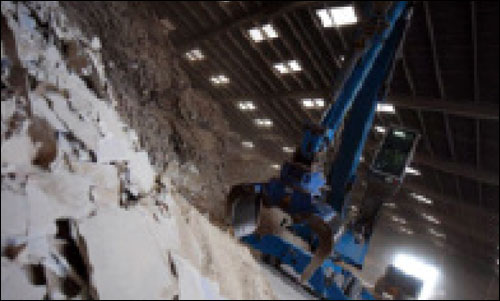Each year, the United Kingdom produces 1 million metric tons of plasterboard waste. Only about 7 percent of this is recycled, and the rest ends up in landfills. But the gypsum in plasterboard—sometimes called gypsum board or sheetrock—can mix with organic waste to produce hydrogen sulfide gas, a colorless and poisonous mixture that can cause significant health problems.
In November 2008, the U.K. government began requiring contractors to separate plasterboard from other waste materials, so the plasterboard can be disposed of at one of four “mono-cell” landfills. But currently, there is no way to monitor whether contractors are complying with these regulations. Tony Atkins, a member of Applied Computing in the Faculty of Computing, Engineering and Technology at Staffordshire University, and colleagues Lizong Zhang and Hongnian Yu, have developed a system for tracking plasterboard to monitor compliance.
The system involves tagging shipments of plasterboard for a new building or one that is being renovated, to track how much plasterboard is used. Plasterboard waste—either “off-cuts” from new construction or old plasterboard that is removed—is loaded into containers equipped with passive ultrahigh-frequency RFID tags. When these are filled, the system estimates the volume and weight of the waste, based on the container size. That tonnage is compared with the estimated waste, based on an analysis of the building’s blueprint and amount of new plasterboard brought to the site. If there is less plasterboard removed than consumed, it might indicate that some of the plasterboard being removed was disposed of improperly.
GPS would be used to track the shipment to ensure the waste is hauled to the correct disposal site. (The process of filling the container with plasterboard could be videotaped, and the RFID transponder could store a link to the video on the Web.)
“Our system lets you calculate the volume and tonnages, and do the track-and-trace to show that you are a responsible contractor and have disposed of this waste properly,” Atkins says. “This is not a requirement today, but it could become a requirement because the amount of construction waste continues to increase every year.”
Atkins envisions using ant colony optimization—algorithms that determine the most efficient route given a set of variables—to find the most efficient and cost-effective way to truck containers of plasterboard waste to recycling facilities or special landfills. This would help reduce the cost burden on contractors.
“We have talked to a recycling plant in this area about our systems,” Atkins says. “Ideally, it should be adopted by the companies that produce the plasterboard. We plan to see if they are interested in adopting our system. If legislation changes to require proof that plasterboard has been disposed of properly, contractors might be more interested in using it. The technology already exists to make it feasible.”


